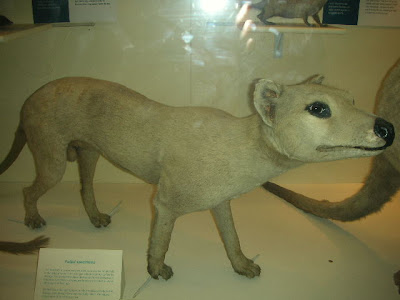
CFZ member Neil Arnold visited the Natural History Museum in London recently and took in some of its cryptozoological exhibits - two of which are relatively close to home for us!
Monster hunters of the Southern Hemisphere cfzaustralia@gmail.com


Two Aboriginal rock paintings of Tasmanian Tigers (Thylacine cynocephalus: dog-headed pouched-dog) have been found in a hidden art gallery in the Northern Territory.
The paintings were found within an "art gallery" spanning 20,000 square kilometres of Indigenous Jawoyn land from Katherine up to remote Arnhem land.
Jawoyn Association Cultural Manager Ray Whear is convinced it's the extinct animal. The paintings will be included in a database destined to be the largest indigenous rock art collection in the world.
Posted on June 2, 2009, 6:06pm
A Donovans man says he saw an animal on Monday afternoon that resembled a Tasmanian tiger.
Richard Elliott was driving along Dry Creek Road toward Princess Margaret Rose Cave when he observed the mystery animal near a pine plantation about 3.30pm.
"At first I thought it was a fox, but it was too long and gangly," Mr Elliott said. "It had a long tail; it definitely wasn't a fox."
Mr Elliott said the animal was definitely not a dog or a cat either. It moved into the bush too quickly for him to determine if it had stripes.
Mr Elliott said the animal was long and skinny, with exposed ribs.
The Tasmanian tiger, or Thylacine, is believed to have become extinct when a captured animal died in 1936.
There have been no officially verified sightings of a Thylacine in mainland Australia, but many unconfirmed sightings have been reported in the South East of South Australia, Western Victoria and South Gippsland.

On January 17, 2005, Richard Cooper saw a thylacine in the Great Dividing Range east of Melbourne.
"It was daylight, mid-afternoon. Fifty yards ahead of me an animal crossed the track slowly. It was Golden retriever size, as clear as day, and I could see the set of impressive stripes down its back. It was a Thylacine. I felt very fortunate enough to have seen it.”
http://forteanzoology.blogspot.com/2009/10/neil-arnold-thylacine-sighting.html
 A 1978 yowie encounter in the Northern Territory has inspired a play that is now touring the country.
A 1978 yowie encounter in the Northern Territory has inspired a play that is now touring the country. Ouch! When this whopping grouper fish washed up on Townsville Strand in Queensland this week, the government veterinary pathologist Dr Ian Anderson had a poke around inside and - wha-la! One sizeable (and sadly deceased) 40cm green turtle was tucked away inside. Obviously not more than a mouthful for this plucky predator!
Ouch! When this whopping grouper fish washed up on Townsville Strand in Queensland this week, the government veterinary pathologist Dr Ian Anderson had a poke around inside and - wha-la! One sizeable (and sadly deceased) 40cm green turtle was tucked away inside. Obviously not more than a mouthful for this plucky predator!